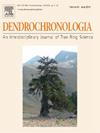Tracheid anatomy of Cryptomeria japonica grown in a humid temperate region: A proxy for short-term climate variability and a crossdating index
IF 2.7
3区 农林科学
Q1 FORESTRY
引用次数: 0
Abstract
The tree and site selection principle established for dendrochronology and its subfields has long been used as a standard reference for maximizing the climatic signal recorded in ring widths. However, this principle suffers from its stringent restrictions on available tree species and age, and a minimum number of ring widths. Additionally, a limitation of using ring widths is that it fails to capture the detailed responses to signals from short-term climatic variability preserved in wood chemistry and cellular anatomy. Recently, stable isotope and quantitative wood anatomy have shed light on these perspectives, enabling the extraction of climatic signals even from specimens that were previously considered unsuitable. This study aims to evaluate the potential of quantitative tracheid anatomy in Cryptomeria japonica trees of approximately 70 years of age from a humid-temperate region, Ashiu Forest Research Station, as a proxy for climate signals and a crossdating index, despite being suboptimal under conventional dendrochronological principles. Specifically, lumen radial diameter and cell wall thickness were analyzed for the period between 1965 and 2016. According to a correlation analysis, daily precipitation in July (rainy season) of the current year was highly correlated with the lumen radial diameter (r = 0.71). The lumen radial diameter was also useful for reliably crossdating (Student’s t-value = 7.34) C. japonica specimens from 1965–2016 that could not be crossdated by ring widths. The study findings suggest the possibility that tracheid anatomy of C. japonica may serve as a proxy for climatic variability and a crossdating index in humid-temperate regions.
生长在湿润温带地区的日本柳杉的管胞解剖:短期气候变率和交叉年代指数的代理
长期以来,树木年代学及其子领域建立的树木和选址原则一直被用作最大限度地利用年轮宽度记录气候信号的标准参考。然而,这一原则受到其对可用树种和树龄的严格限制以及最小年轮宽度的限制。此外,使用环宽度的一个限制是,它不能捕获木材化学和细胞解剖中保存的短期气候变化信号的详细响应。最近,稳定同位素和定量木材解剖揭示了这些观点,甚至可以从以前认为不合适的标本中提取气候信号。尽管传统的树木年代学原理并不理想,但本研究旨在评估湿温带地区阿丘森林研究站约70年树龄的日本柳杉(Cryptomeria japonica)树木的定量管胞解剖作为气候信号和交叉测年指标的潜力。具体来说,我们分析了1965年至2016年期间的管腔径向直径和细胞壁厚度。相关分析表明,当年7月(雨季)日降水量与管腔径向直径高度相关(r = 0.71)。管腔径向直径对于1965-2016年无法通过环宽度进行交叉年代测定的日本刺青标本也很有用(Student 's t-value = 7.34)。本研究结果提示,在湿温带地区,粳稻的管胞解剖结构可能作为气候变异和交叉测年指标的代表。
本文章由计算机程序翻译,如有差异,请以英文原文为准。
求助全文
约1分钟内获得全文
求助全文
来源期刊

Dendrochronologia
FORESTRY-GEOGRAPHY, PHYSICAL
CiteScore
5.50
自引率
13.30%
发文量
82
审稿时长
22.8 weeks
期刊介绍:
Dendrochronologia is a peer-reviewed international scholarly journal that presents high-quality research related to growth rings of woody plants, i.e., trees and shrubs, and the application of tree-ring studies.
The areas covered by the journal include, but are not limited to:
Archaeology
Botany
Climatology
Ecology
Forestry
Geology
Hydrology
Original research articles, reviews, communications, technical notes and personal notes are considered for publication.
 求助内容:
求助内容: 应助结果提醒方式:
应助结果提醒方式:


